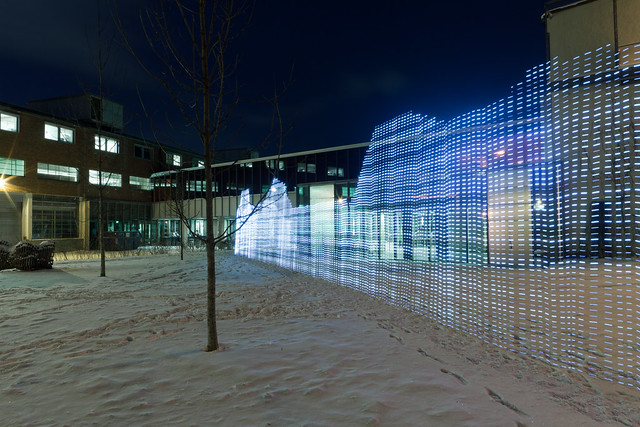The thing with finding is that there is more to the way of finding than the way of searching. Some things just don't want to be found, you run into them.

Image taken from Ti.Mo on flickr / Walking the pole at night in Oslo, tracing the Wi-Fi quality.
However, in this case the desired thing, if it is one, is invisible. It requires an invention to actually make it visible. The waves of the wireless network swirling the urban spaces are no where to be seen other than on the display of your gadget in the form of four stacked arches. This is sort of point information concerning just the immediate location. And if you have ever tried to catch a signal in an awkward spot, you must have experienced how much difference one side step can make, or half a pirouette, wonders.
The guys over at touch have invented the ultimate light painting rod to visualise exactly these waves. This is not coming out of the bue though. There is some history to this. In short, they where earlier experimenting with RFID working on the nearness project, together with berg. In a next step they used a similar approach, on much small scale, to visualise the transmitter field of the RFID reader. In this sense the visualisation of the Wi-Fi is some sort of large scale, real world implementation. They also experimented with the visualisation of Wi-Fi earlier. This new very much hands on approach works amazingly well in terms of the images it produces. I guess this is the nice thing with finding the treasure, you get to give it an image, you can brand it.

Image taken from Ti.Mo on flickr / Detail of the rod with LED lights and loads of wiring.
They explain "we built the WiFi measuring rod, a 4-metre tall probe containing 80 lights that respond to the Received Signal Strength (RSSI) of a particular WiFi network". As they take the rod for a walk the light indicate the signal strength vertically. Amazingly the fluctuations in signal quality are dramatic, making it possible to differentiate changes on a step by step basis. It would be quite cool to attempt a surface modeling. Maybe as a section by section path across could generate a leveled view? As a distant relative of this tool the pole land surveyors use comes to mind with the red and white markings. In reference to one point the profile of the topography is charted. Similarly this could be implemented here. As it looks on some of the photographs they are using a visualisation software on the laptop to record the measurements. Seems to be built with processing, maybe this can be reused if they simultaneously record the location via GPS for examples. Maybe it could even be developed into a mobile application using a mobile device as the flashing light, being this the iPhone or the iPad as for example shown in light paintings developed by berg as part of the making future magic project.
In a way the landscape the rod is making visible is not too disimilar from the New City Landscape (NCL) we developed from twitter messages. Both are providing an interface between real world and virtual world.
The photographs used here were shot in the Grünerløkka area in Oslo. The lighting works really nicely against the backdrop of dark buildings and white tones of the snow cover. As they point out in some of the write ups there is a fascinating relaionship to the architecture around in terms of scale. The super human size of four meter matches about one story of a building picking up the architectural line and stepping out of the human reference. This gives it a more objective relevance, looking very meaningful.

Image taken from Ti.Mo on flickr / Visualisation of a cross country cross section.
Tidak ada komentar:
Posting Komentar